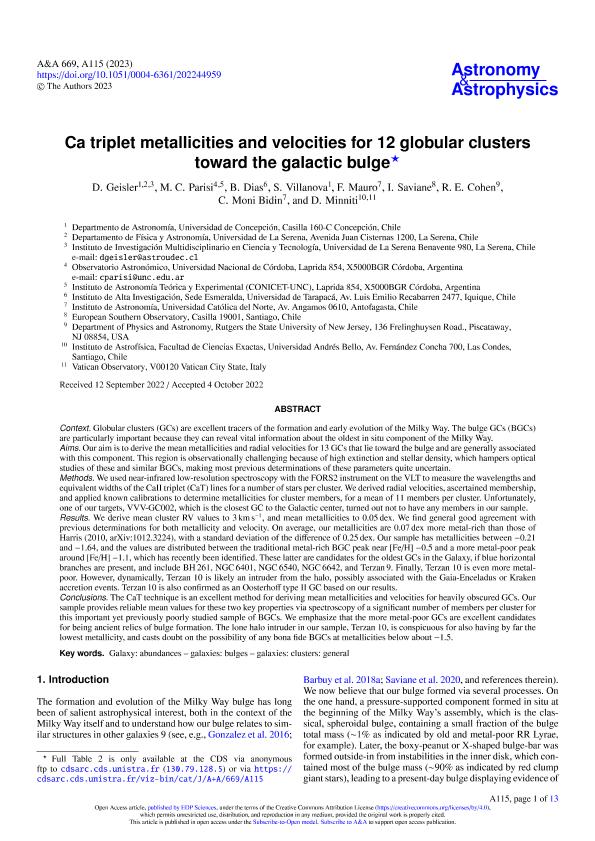Artículo
Ca triplet metallicities and velocities for 12 globular clusters toward the galactic bulge
Geisler, D.; Parisi, Maria Celeste ; Dias, B.; Villanova, S.; Mauro, F.; Saviane, I.; Cohen, R. E.; Moni Bidin, C.; Minniti, D.
; Dias, B.; Villanova, S.; Mauro, F.; Saviane, I.; Cohen, R. E.; Moni Bidin, C.; Minniti, D.
 ; Dias, B.; Villanova, S.; Mauro, F.; Saviane, I.; Cohen, R. E.; Moni Bidin, C.; Minniti, D.
; Dias, B.; Villanova, S.; Mauro, F.; Saviane, I.; Cohen, R. E.; Moni Bidin, C.; Minniti, D.
Fecha de publicación:
01/2023
Editorial:
EDP Sciences
Revista:
Astronomy and Astrophysics
ISSN:
0004-6361
Idioma:
Inglés
Tipo de recurso:
Artículo publicado
Clasificación temática:
Resumen
Globular clusters (GCs) are excellent tracers of the formation and early evolution of the Milky Way. The bulge GCs (BGCs) are particularly important because they can reveal vital information about the oldest in situ component of the Milky Way. Aims. Our aim is to derive the mean metallicities and radial velocities for 13 GCs that lie toward the bulge and are generally associated with this component. This region is observationally challenging because of high extinction and stellar density, which hampers optical studies of these and similar BGCs, making most previous determinations of these parameters quite uncertain. Methods. We used near-infrared low-resolution spectroscopy with the FORS2 instrument on the VLT to measure the wavelengths and equivalent widths of the Call triplet (CaT) lines for a number of stars per cluster. We derived radial velocities, ascertained membership, and applied known calibrations to determine metallicities for cluster members, for a mean of 11 members per cluster. Unfortunately, one of our targets, VVV-GC002, which is the closest GC to the Galactic center, turned out not to have any members in our sample. Results. We derive mean cluster RV values to 3 km s~1, and mean metallicities to 0.05 dex. We find general good agreement with previous determinations for both metallicity and velocity. On average, our metallicities are 0.07 dex more metal-rich than those of Harris (2010, arXiv: 1012.3224), with a standard deviation of the difference of 0.25 dex. Our sample has metallicities between -0.21 and -1.64. and the values are distributed between the traditional metal-rich BGC peak near [Fe/H] -0.5 and a more metal-poor peak around [Fe/H] -1.1, which has recently been identified. These latter are candidates for the oldest GCs in the Galaxy, if blue horizontal branches are present, and include BH261, NGC6401, NGC6540, NGC6642, and Terzan9. Finally, Terzan 10 is even more metal- poor. However, dynamically, Terzan 10 is likely an intruder from the halo, possibly associated with the Gaia-Enceladus or Kraken accretion events. Terzan 10 is also confirmed as an Oosterhoff type II GC based on our results. Conclusions. The CaT technique is an excellent method for deriving mean metallicities and velocities for heavily obscured GCs. Our sample provides reliable mean values for these two key properties via spectroscopy of a significant number of members per cluster for this important yet previously poorly studied sample of BGCs. We emphasize that the more metal-poor GCs are excellent candidates for being ancient relics of bulge formation. The lone halo intruder in our sample, Terzan 10. is conspicuous for also having by far the lowest metallicity, and casts doubt on the possibility of any bona fide BGCs at metallicities below about -1.5.
Palabras clave:
GALAXIES: BULGES
,
GALAXIES: CLUSTERS: GENERAL
,
GALAXY: ABUNDANCES
Archivos asociados
Licencia
Identificadores
Colecciones
Articulos(IATE)
Articulos de INST.DE ASTRONOMIA TEORICA Y EXPERIMENTAL
Articulos de INST.DE ASTRONOMIA TEORICA Y EXPERIMENTAL
Citación
Geisler, D.; Parisi, Maria Celeste; Dias, B.; Villanova, S.; Mauro, F.; et al.; Ca triplet metallicities and velocities for 12 globular clusters toward the galactic bulge; EDP Sciences; Astronomy and Astrophysics; 669; 1-2023; 115-128
Compartir
Altmétricas



